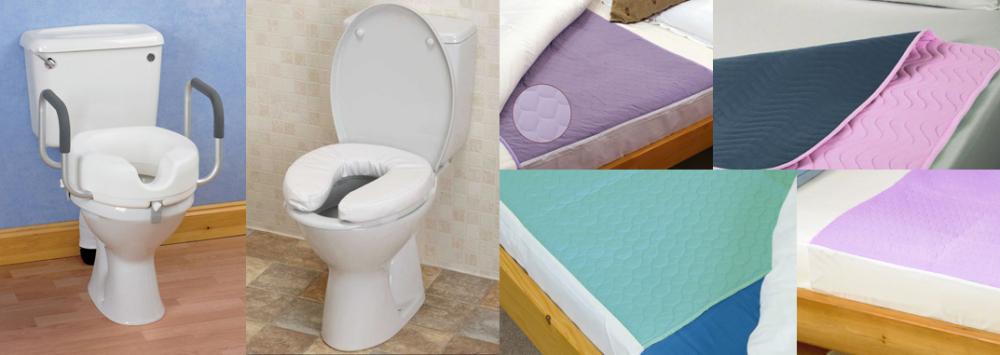
Incontinence, Quality of Life and Restful Sleep
Sally Madeley-Carr, OT29 Nov 2021
Loss of bladder control can come about as a result of diabetes, the menopause, an enlarged prostate, lifestyle and also as a result of other illnesses and certain medications.
Urinary incontinence can cause great embarrassment and also lead to isolation, as the individual affected may find socialising somewhat challenging.
Urinary Incontinence Explained
Urinary incontinence can be classified as stress incontinence, urge incontinence, overflow or total:-
Stress incontinence is when the pressure in the bladder becomes stronger than the strength of the urethra (the doorway to the bladder) to contain the urine content.
Urge incontinence is when the detrusor muscles in the bladder contract too often and create a need to quickly pass urine.
Overflow incontinence can be when the detrusor muscles don't contract fully and cause the bladder to stretch. This condition is often caused by an obstruction or a blockage, meaning that the bladder cannot completely empty itself and so frequent leaking becomes a possible factor.
Total incontinence means that the bladder cannot contain any urine and the individual passes a lot of urine, or has regular toilet seat riser visits and frequent leaks in between.
Risk factors to incontinence can include regular urinary tract infections (UTIs), age and family history.
How to Reduce Leaks
There are several points that the individual can take into account, to lessen the development of leaking:-
- Smoking can increase incontinence, as regular coughing can loosen the pelvic muscles
- Lifting and carrying can weaken pelvic muscles, so mentally work at tightening the pelvic muscles before lifting weight of any kind
- Fatty tissue from being overweight can put pressure on the bladder
- Efforts taken when constipated can both weaken the pelvic muscles and worsen and urinary infections present. Change both your diet and lifestyle, to reduce the likelihood of constipation
- Caffeine is present in coffee, tea, green tea, fizzy drinks, energy drinks and hot chocolate and can irritate the bladder, making incontinence worse
- Alcohol is a diuretic and so causes you to urinate more often. Cut down on consumption to reduce the effects on the bladder
- Cut down on acidic and spicy foods, as they can worsen incontinence symptoms.
Keeping Dry
Keeping dry means protecting one's skin and keeping clothes, chairs, beds and bed linen free from dampness, odour, stains and discolouration.
Finding the most comfortable incontinence control during the day helps keep life how it is meant to be.
The most comfortable way of keeping dry during the night will aid restful sleep and make for a more positive day.
Daytime
There are a lot of products available for people who wish to control their bladder upset and get on with quality, daily life:-
- Pads and Pull-Up Pants
Like babies' nappies, pads and pull-up pants include a hydrophobic layer which, by drawing the liquid away from the top layer of the product, keeps the user's skin dry. This will contribute to preventing infection and lessening the development of sores.
Pull up pants have a breathable back sheet which supports a flow of air and keeps skin fresher. Easy to use, these pants help the skin remain unbroken from dampness or infection.
Pads and pull up pants come in a range of absorbency levels, from small leaks to more intense incontinence.
- Incontinence Pads
Incontinence pads are more bulky and are used by people with more severe incontinence problems.
An incontinence pad can hold up to two or three times the volume of urine excreted from one full emptied bladder.
One thousand mls. (1 2/3 pints) of urine weighs similar to a bag of sugar. Regular changing is therefore recommended, as a heavy incontinence pad will prove very uncomfortable.
Incontinence pads and pants are in both male and female designs, to allow for a better fit.
Sanitary pads are not recommended as a cheaper option, as they tend to remain wet and can cause sores to the skin.
- Chair Protection
Incontinence chair pads help keep chair seats dry and clean and are easily washable. Always buy several chair pads, so that more than one chair is protected at all times, allowing the person with the bladder upset to move freely from one chair or room to another.
Incontinence chair pads can also be used in the car, to protect the seat from dampness, odour and staining, keeping travelling by car firmly on the list of one's pleasures.
Night-time
Having to change a wet bed during the night is an experience to be avoided, due to disturbed sleep, cleaning and the time taken for all tasks.
A mattress can be kept dry and hygienic by using:-
- A zipped, waterproof, mattress cover - this covers the whole mattress and can be easily wiped clean and deodorised
- A mattress protector - mattress protectors cover your bed like a fitted sheet and are made from water resistant materials. They protect the mattress from spills, sweat and other allergens.
- A waterproof mattress pad - a waterproof mattress pad does not cover the whole of the mattress but offers protection in a particular area of the bed, from the chest down to the foot of the bed. It is a multi-layered sheet which proves to be highly absorbent. If made of paper, it is disposable and, if made of cotton, it is washable
- Washable incontinence bed pads (also known as reusable bed pads) can be placed either on top of, or under, the mattress protector, to keep the mattress dry from urine spills and other body fluids
- A catheter is a thin tube which, when inserted into the bladder, allows urine to flow freely into a drainage bag which is held at the thigh or calf
- For males, the catheter tube enters the bladder through the penis. For females, the catheter enters the bladder through a small hole made in the tummy.
Catheter Side-Effects
The side-effects of using a catheter include:-
- Headaches
- Chills
- Cloudy urine
- Pain in the genital area
- Blood in the urine
- Foul smelling urine.
Bowel Incontinence
Bowel incontinence is when you find it sometimes difficult to control your bowels. It affects one in five people aged over sixty five and rises for people aged eighty and over.
Bowel incontinence is not a natural part of ageing but older people are more at risk of developing the condition.
Bowel incontinence can present itself as:-
- When you soil yourself without knowing
- When an urgent need to go can't be held onto
- When passing wind can lead to some spillage.
If the accidents become regular, this will greatly affect quality of life and socialisation. Your first action should be to seek medical attention. This condition can often be treated with medication, though visiting the doctor should always be looked upon as a priority.
Treatment could include:-
- Changing your diet to foods which are less likely to cause diarrhoea or loose stools
- Medicine to reduce diarrhoea and constipation
- Incontinence pads and / or small plugs which can be inserted into your bottom
- Pelvic floor exercises which can help you strengthen muscles which control your bowels.
There are many causes for bowel incontinence, including bleeding piles, constipation and diarrhoea, irritable bowel syndrome (IBS), Crohn's disease (inflammatory bowel syndrome), childbirth (which causes stretching of the muscles) and also conditions which can affect nerve endings e.g. a stroke and diabetes.
For bowel incontinence, pads are preferred over and above pants.
When choosing the most effective bowel incontinence pad, look for pads which:-
- Are friendly to the skin - some people are allergic to latex, so take this into account when purchasing
- Give a high degree of comfort (belted pads or smaller pads)
- Have an absorbency which matches the user's level of need (normal, plus, super plus and maxi)
- Fit close to the body
- Indicate the level of wetness, so as to know when to change the pad
- Neutralise odour, so that you know that others won't notice.
Active or Inactive?
An active person may make different choices to an inactive person, as to what is the best bowel incontinence pad to wear.
An active person will be better suited to choosing a shaped pad, as this will accommodate movement and general activity.
An inactive person will find an all in one pad the better choice, as they don't need changing as often and are easier to remove (e.g. fixation or Velcro pads), even when the user is lying down.
Summary
When choosing the right incontinence pad to purchase, points which must be taken into account include are:-
- Whether the user is male or female
- Whether the incontinence loss is mild, average, or intense
- Whether the absorbency level meets the needs of the user
- Whether the person is active or inactive.
Protecting a bed mattress from incontinence will promote restful sleep.
Washable incontinence bed pads are a must for keeping the mattress dry and hygienic.
By addressing one's personal lifestyle, leaking can be reduced and quality of life can be brought back up to standard.
Always confirm the cause of incontinence with your doctor, as there may be medication which can greatly help with solving or managing the issue.

Sally Madeley-Carr, OT
Sally qualified as an Occupational Therapist in 1996 and is a well-respected professional in the field of rehabilitation equipment and living aids. She has worked in private practice and within the NHS, developing a broad experience with adults and children. Click here for Sally's registration with the Health and Care Professions Council. The HCPC regulates health, psychological and social work professionals in the UK.